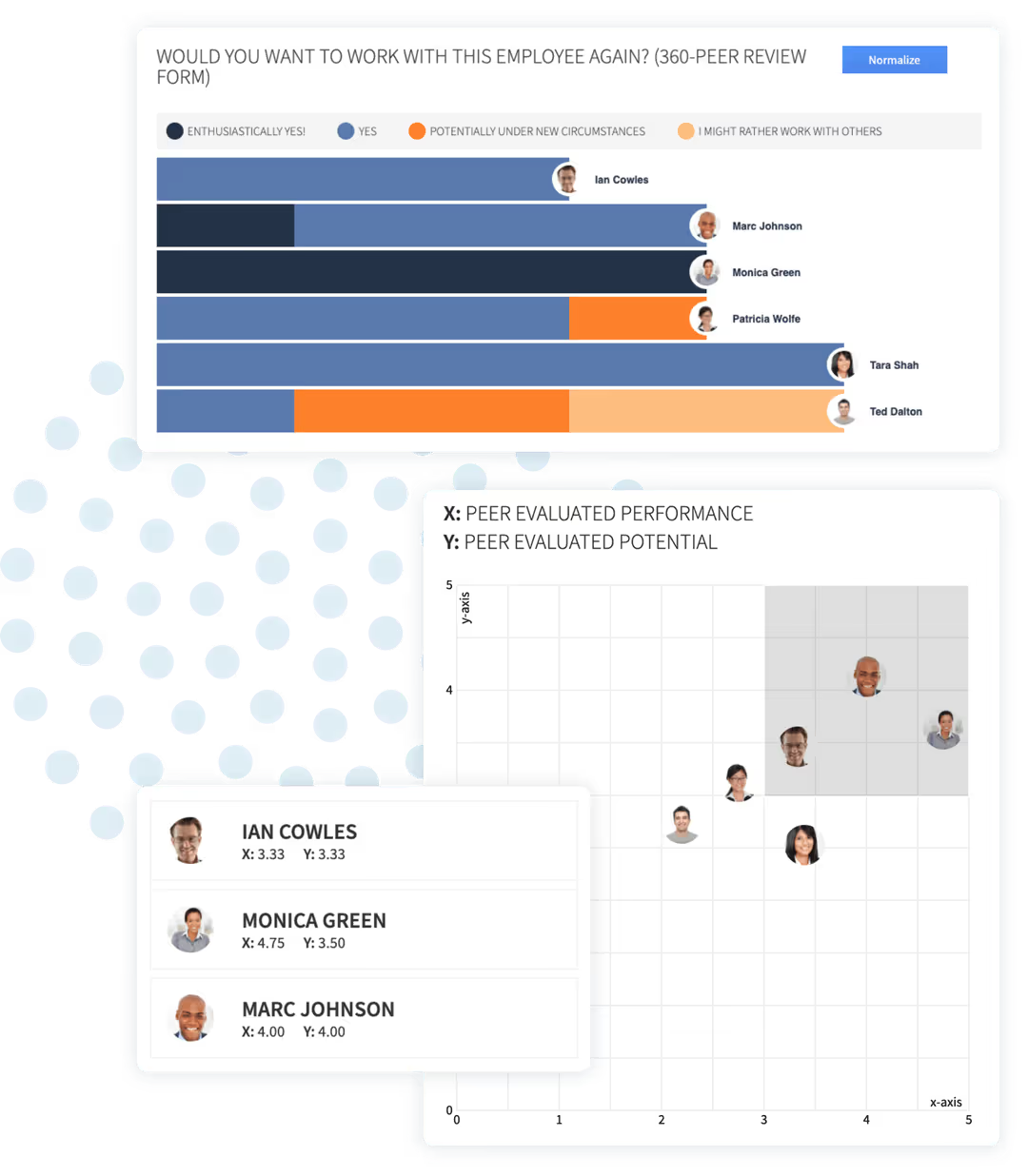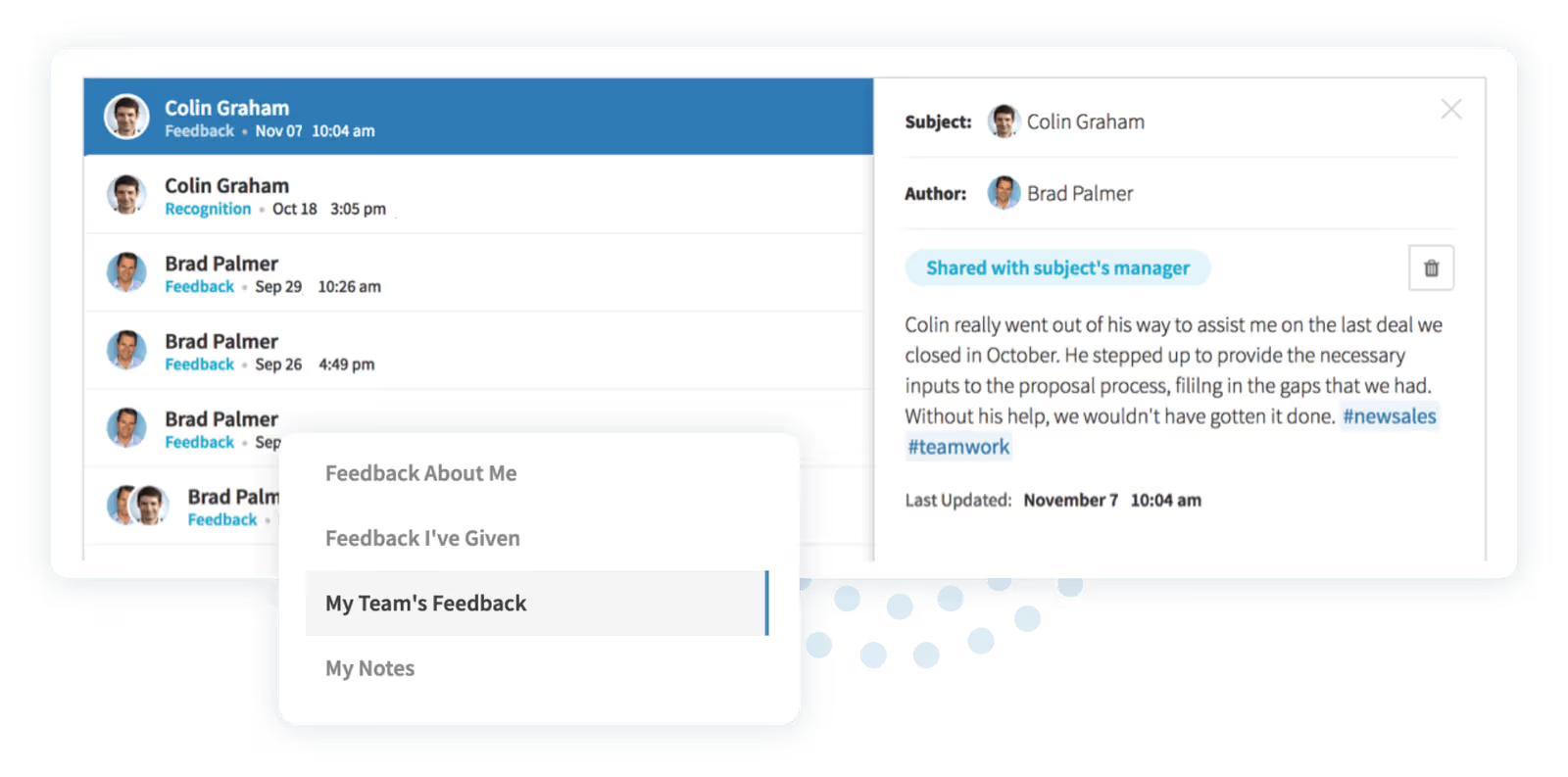Free Annual Performance Review Template
The Annual employee performance review is a crucial tool for measuring and compensating employee performance.
Employees get to highlight their growth and contributions. Managers can partner with direct reports to examine opportunities for continuous improvement. The executive board can get a great view of the company's overall success going into the next year.
Free Annual Employee Performance Review Template
Click here to download PDF
Annual reviews should be a culmination of a year-long process to create goals, track progress, and promote their completion. Nothing in an annual review should surprise the employee or their manager.
There are several methods for completing the annual review, such as the 360 review or the traditional manager/direct report review. Each model provides different strengths that your organization should examine to determine the best fit.
Annual Reviews: Three reasons why you should use them…and two reasons you may want to reconsider.
Annual reviews are one of the best tools for gauging and compensating employee performance. But, putting too much weight on one review can lead to an imperfect picture of employee performance. It’s critical to achieve the right balance.
So why should you consider adopting annual performance reviews?
Everyone sees the big picture
Annual performance reviews examine an employee’s performance across an entire calendar year. They provide a holistic view of a team member's core competencies, contributions, and quality of work.
Employees can call out their wins and see how they progressed. Managers can mention how an employee’s performance changed across the year. This allows both parties to examine trends in performance, and understand why those trends occurred.
Maybe an employee’s sales numbers suffered around May before picking up in July.
Was this common across the organization, or simply unique to this employee?
What was the employee working on while this slip occurred?
Each goal that an employee sets can be examined with finality.
Did the employee meet the goal?
If not, where and why did they come up short?
Trends can be deduced. Perhaps an employee met 5 out of 6 very ambitious goals but came up just short on the last one. That is different from an employee who only met 4 out of 6 goals, and barely made headway on her final two goals.
This annual review gives a manager a strong understanding of how effective a direct report has been over an entire year. The manager can see how much the employee contributed to the company and if the employee is improving.
Employees can highlight all the accomplishments they’ve completed
Annual reviews are a great opportunity for employees to say, “Look at all I’ve done.” They can showcase their contributions to the organization, such as improved communication skills or problem-solving and receive positive feedback for their achievements.
Oftentimes, managers are stretched thin, and may not be aware of all the great work each direct report has accomplished. An annual review allows employees to present all of their best “wins” so their managers can see how invaluable their work has been.
When using quarterly or mid-year reviews, some large accomplishments aren’t picked up on. This usually happens because they're still incomplete or haven’t yet shown their worth. The annual review is when these projects will have likely borne fruit. Employees should proudly showcase the results of their ingenuity and hard work.
Your company gets actionable data
Using a Performance Management System like PerformYard gives you access to actionable data about the company, team, and individual performance.
- See how an employee’s performance stacks up against their previous review cycles.
- See how a team’s performance compares to its previous review cycles.
- See how the entire company is performing relative to organizational goals.
This type of hard data is excellent for determining compensation and promotions -- one of the key reasons why annual reviews are completed in the first place.

You’ve identified your top performers. Now you need to compensate them fairly.
Two reasons to reconsider annual reviews
Annual reviews have some drawbacks that need to be understood before you move forward with a review structure. Annual reviews can put undue stress on one single meeting and are not as effective for recalibrating employee engagement or performance. However, coupling annual reviews with additional reviews throughout the year mitigates these drawbacks.
Annual reviews are high-stakes
Annual reviews are a big deal. Most compensation and promotion decisions are based on an annual review. If it goes poorly for an employee, that can mean a significant difference in overall compensation.
If your organization chooses to only do an annual employee review, you risk breaking the cardinal rule of performance reviews: nothing should be a surprise. Employees should always go into any review understanding where they are exceeding and where they need to work harder.
Annual reviews work best in union with check-ins, quarterly reviews, or mid-year reviews. This way, employees and managers have already identified pain points and taken ample steps to correct them.
If these check-ins haven’t happened, team members may be blindsided with a negative review. They may feel hurt and their performance may suffer even more. Plus, you have missed many opportunities to improve performance and build on employee strengths along the way.
If you had taken a little time to add in some extra reviews, your employee may have improved. More so, your business may have increased and everyone would have been happier come the next performance review.
Annual reviews are not great at recalibrating employee performance
If you only use an annual review, you lose the ability to provide clear and actionable feedback on issues as they arise. Let's take a specific example -- if your employee botched a presentation in March, and they only got feedback about it in December, they'll find it hard to implement that feedback into their next performance.
Constructive feedback is effective when it is timely. Annual reviews don’t allow you to be timely in your feedback. Instead, they focus on examining an employee’s overall performance over a year.
This is why we recommend pairing annual reviews with quarterly reviews, mid-year reviews, or frequent check-ins, especially for new employees. This allows managers to steer the development of their employees and ensure they put their best foot forward at the annual review.
Goals of Yearly Appraisal Meetings
The goal of a yearly performance appraisal meeting, or annual performance review, is for the employee and organization to have a clear, actionable understanding of how an employee has performed and evolved over an entire year.
- Did they achieve all of their goals?
- Did they fix performance issues from a previous review period?
- Have they brought significant benefits to the business?
- How does their performance compare to that of their peers?
The answers to these questions will be found in an effective performance appraisal process. Once this data is gleaned, it will be used to make effective and transparent compensation decisions.
Jenny made 120% of her sales goal, so she gets X bonus.
Seeing how an employee has taken on and accomplished more challenging goals can be invaluable for determining promotions. With PerformYard, you can look at an employee’s performance review relative to their previous years’ reviews, allowing you to see how they have evolved. It’s an excellent way to make informed and data-based promotion decisions.
How to Structure an Employee Evaluation Meeting
Once you and your team have completed your evaluations, it is time to have the employee evaluation meeting. This is the time for face-to-face conversations about performance, accomplishments, and improvements. Structuring this interview is critical. You want to keep the conversation productive and constructive, not condescending or demeaning.
Start with their goals
Discussing future goals first may seem counterintuitive, but it helps inform the discussion about performance. If your employee tells you at the beginning of the review meeting, “I want to focus much more on client-facing components of my job," you can steer the conversation around their client-facing accomplishments.
You can also explain your goals for your partnership with your direct hire and the greater team. Open yourself up a little, and show your employee how they can help you become a more effective manager for them.

Talk about the successes
It is often helpful to ask your employee to present what they see as their biggest successes. This will help you to not overlook any of their accomplishments and will help reduce any anxiety about the performance review itself.
Encourage your employee to explain how their achievements and past performance have positively impacted the company. This will help them see their strategic value, and give them insight into the overall performance review score and compensation decisions.
After your employee has summarized their successes, take time to call out some other achievements they haven’t mentioned – particularly ones that you feel are important to the company. If your employee calls out an achievement that you don’t believe holds much strategic value, gently push back and explain how their efforts may be better suited to another project.
Constructively examine areas for improvement
Ask your employee where they believe they have the most room for improvement. Having them start the conversation will reduce potential defensiveness, and position this discussion to be productive. As your employee raises their weak spots, take time to affirm or push back on their conclusions, and then ask them open-ended questions on how they think they could improve.
Again, having the employee lead this portion of the review will lead to better buy-in and less defensiveness, especially for new hires.
After your employee has offered their solutions, you should affirm they are good ideas and offer some solutions of your own that can fit into their performance improvement or development plan. Explain how you believe that these actions will lead to them developing and improving – which will help them grow with the company and align with organizational goals.
Finally, end by reaffirming the good work your employee has accomplished. Assure them that the two of you will work as a team to continue the good work next year.
What type of annual review should I use?
Two types of annual reviews are typically used: the manager + direct report or the 360 review process. Each has its strengths and weaknesses.
The manager + direct hire review is the most focused.
1. A direct hire fills out a self-evaluation
2. The manager completes an evaluation of the employee
3. The two have a face-to-face discussion where the direct hire’s job performance is examined.
This review has the benefit of requiring only 2 reviews per employee, meaning that all reviews can be completed on time.
The downside is that a manager gets limited feedback. They only have their performance evaluation and their employee’s self-evaluation to work with. There is no context provided by peers or other colleagues who work with their direct hire.
The more full review, the 360 review, incorporates additional feedback from peers and others who work directly with the employee. This can provide additional context and help an employee see how they contribute to an organization. However, they can be difficult to execute because they require employees to fill out multiple reviews, which can make the review process very time-consuming.

How can I improve my annual review process?
Annual performance reviews can be improved by using a dedicated performance management system like PerformYard.
PerformYard streamlines the review process by centralizing all performance and review data. This data lives in a single sign-on platform that all employees can access. PerformYard lets HR managers create custom review forms, schedule the performance cycle, and automatically notify employees of outstanding tasks. Employees can see all of their remaining tasks (review completion and goal setting) in a user-friendly dashboard.
No more complicated paper forms. No more redundant emails. No more chasing down stragglers. Automated, streamlined review cycles.
Curious to see how PerformYard can take your review cycle from cluttered to empowered? Reach out today to get a free PerformYard demo!
FAQs
Q: How do you write an annual performance review?
A: An annual performance review should cover the work the employee has accomplished or not completed; it should not be about their personality. An easy way to focus a performance review is to examine an employee’s goals and follow an action plan. Were the goals met? Were they surpassed? Which goals were not achieved?
Conversely, you can write an annual performance review around the organization’s core values. Which tasks did the employee complete that embodied value X? Value Y?
Q: How do I structure an annual performance review?
A: Employee reviews often excel when they are tied to performance, not personalities. We find that the best way to structure the review is through goal-setting. Goals should be set far in advance, achievable yet challenging, quantifiable, and trackable.
An effective performance review should focus on if those goals were achieved. What did the employee and their manager set out to accomplish? Were those goals met?
After goals have been examined, it is best to then examine the employee’s achievements and their key areas of improvement. These three components will give a holistic view of the employee.
Q: Should annual reviews be tied to compensation?
A: Most annual reviews are tied to compensation, as raises and salaries are only given out once a year. The annual review is a great tool to use to determine the correct compensation for each employee, as you can see their entire year’s worth of contribution to your organization.
Q: Where can I get an annual performance review template?
A: Right here! Here’s our free annual performance review template.


.jpg)

